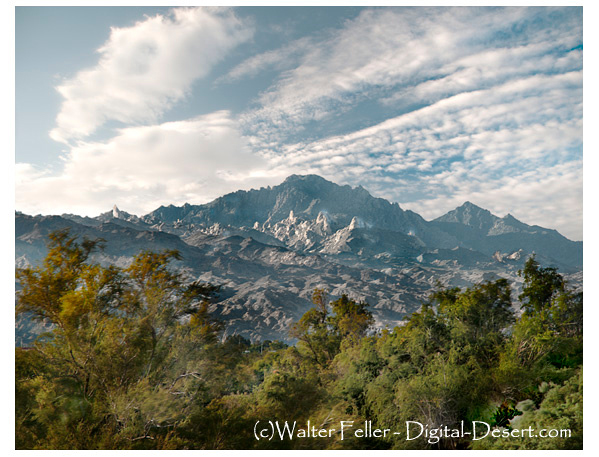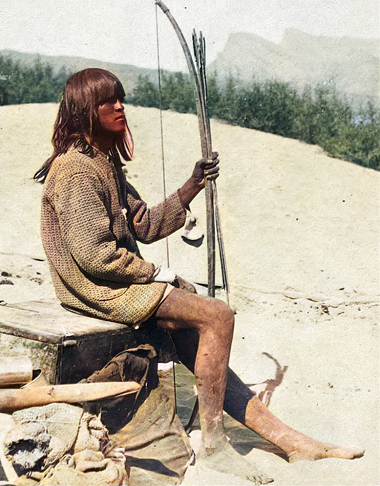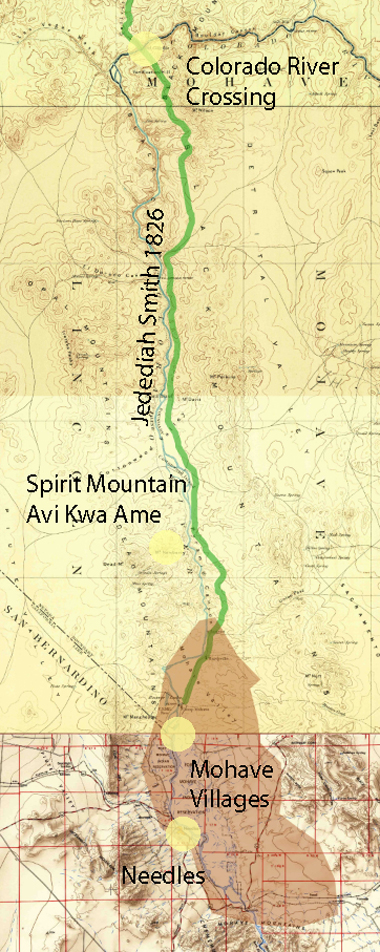The Mohave Villages

I had lost a good many horses and some of those remaining were not able to carry any thing. I got the Indians to assist me in moving down to where there was several lodges. These Indians are quite a different nation from the Pa utch. They call themselves A-muc-ha-ba's and appeared quite friendly bringing me corn beans dried pumpkins &c which I paid them for in Beeds Rings vermillion &c. At this place there is considerable timber on the river and the soil might admit of making small farms. There was but 3 or 4 horses among them but I did not succeed in purchasing them. verry little beaver sign on the river. By enquiry I found that the principal part of this tribe were 30 or 40 miles down the river. I remained at this place 2 days during which time a number of Indians came up from the village below. Among these were one or two that could talk spanish and as I had a man that was able to speak the spanish I could hold some conversation with them. I then moved on down the River accompanied by the Indians who had come up from the settlements below. The distance was upwards of thirty miles and the country barren.
On my arrival at the settlement I was treated with great kindness. Melons and roasted pumpkins were presented in great abundance - At this time it was low water yet the Colorado was 200 yards and in the shoalest place I could find 10 feet deep with a smooth current. The timber in this vicinity consisting of the Cottonwood and a small species of Honey Locust with some willow extends entirely along the river varying in width from 1/2 to 2 1/2 miles in width the river winding through woodland from one side to the other alternately. Leaving the woodland which has a tolerable soil the sandy region commences producing nothing but sedge and prickly pear. On the East and West at the distance of ten miles a chain of Rocky hills run parallel with the river and about thirty miles south the Rocky hills close in to the River. This settlement of the Amuchaba's extending about 30 miles along the River appeared quite numerous and paying some considerable attention to agriculture they do not live in villages but are rather scattered over the country generaly whereever they find the most favorable situations. In person these Indians are tall and well formed complexion not dark. In abilities perhaps second to the Utas. They do not appear much inclined to steal but are quite fond of gambling. Their principal Game is conducted as follows. A piece of ground 30 or 40 feet long and 8 feet wide is made level and smooth. Each man has a pole ten feet long and one of them a hoop 4 inches in diameter. The hoop is set rolling from one end of the floor and at the instant both start and sliding their poles endeavor to intersect the hoop. The one that pierces the hoop or when hoop and poles stop is the nearest to the spot is the winner. The women also gamble by tossing small colored sticks in a dish somewhat like throwing dice. The women are generally very fleshy with tolerable features. The man when dressed at all have a Spanish Blanket thrown over the left shoulder and passing under the right arm it is pined on the breast with a wooden pin. They wear no head dress mocasins or leggings. The dress of the women is a peticoat made of a material like flax just Broken which is Banded with a plat on the upper edge like corn husks. It is fastened around the waist extending down to the knee and constitutes with whole of their clothing. They are in general much more cleanly than the Pautch.
They make a kind of earthen ware and in large crocks of this they boil their beans corn pumpkins &c. The men appear to work as much in the field as the women which is quite an unusual sight among Indians. But few of them have bows and arrows. The bows are 5 feet long and the arrows verry long and made of cane grass with a wooden splice 6 inches long for a head. It is fashion with these indians to fill the hair full of mud and wind it around the head until the top resembles in shap a tin pan. Their summer Lodges about 3 feet high are made of forks and poles covered with grass weeds and dirt flat on the top. The winter Lodges generally small are made in the woods but fronting to the south and where the trees are not sufficiently high to keep out the sun. As the rainy season approaches they throw dirt on the roof to give it a slope to carry off the water and also secure the sides with dirt leaving only a small aperture for a door. As they have not much clothing when the weather requires it they build a great many small fires sleeping in the intervals between them. When they become cold they draw the sand out from under fires and spread it where they sleep. In their Lodges I observed an abundance of Crocks and demijohns. Goards and small bins made of willow in which they put their corn, beans, wheat, garden seeds, and melons. The Honey Locust of this country bears a pod somewhat longer than a bean. The Indians gather these and pound both the pod and the bean it contains until it forms a coarse flour. they work it into loaves and Let it dry it is then fit for use. When they use it they rinse it with water to which it imparts a sweet and yet tartish taste by no means unpleasant. I frequently observed at a distance from their houses willow bins that would hold 20 to 100 Bushels filled with the Locust pods from which circumstances I judged them not much inclined to steal from each other. Their method of grinding their wheat is somewhat tedious. On a large flat stone a little concave it is pounded or rather rolled with another stone in the shape of a bakers rolling pin until it is sufficiently fine. The stone on which the grinding is done being placed in a sloping possition gradually as the meal becomes fine it is permitted to slide off into a dish at the lower end. The bread which they form of this meal is baked in the sand or ashes under the fire without the covering of Bark or grass used by the Pawnees. When they would roast their Pumpkins or Squashes which is common method of cooking them, they take a plug from the side extract the seeds from the hole and replace the Plug by which means they may roast them as neatly as if they were entire.
I found in this vicinity no beaver worth trapping for but remained here for the purposes of recruiting my men and horses. From the Indians I ascertained that below the rocky hills that came into the river and nearly down to the mouth of the Gila the country was barren and not inhabited. they also told me that it was about ten days travel to the spanish settlements in California. I swaped my poorest horses with the indians and endeavored to purchase others but without success.* (* One morning an Indian came to me and said the Indians had killed one of my horses which on examination I found to be true. They had killed the horse to eat and took away every thing but the entrails. from this time I had my horses so carefully guarded that they had no chance to continue their depredations.) Believing it impossible to return to the deposit at this season and in my present situation I determined to prepare myself as well possible and push forward to California where I supposed I might procure such supplies as would enable me to move on north. In that direction I expected to find beaver and in all probability some considerable river heading up in the vicinity of the Great Salt Lake By this route I could return to the deposite. In pursuance of my plan I endeavored by all means in my power to procure a guide but could not succeed. I therefore got the best instruction I could in regard to the route and collected a supply of Corn, Beans, Locust Bread, and a little Indian flour.
< Previous - Next >
Maiman - Mojave
" . . . But few of them have bows and arrows. The bows are 5 feet long and the arrows verry long and made of cane grass with a wooden splice 6 inches long for a head.
